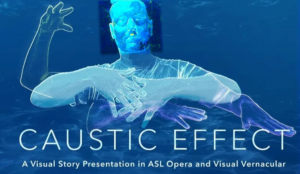
Deafness & Opera In Monique Holt and Landon Krentz’s ‘Caustic Effect – An ASL Opera’
By John VandevertWhile operas that focus on disabilities in the positive, challenging conventional associations of disability and replacing them with affirmative messaging which reflects the tenaciousness of the individual over their situation, one of the last to be adapted into the operatic genre is deafness. Contemporary operas like Errollyn Wallen’s “The Paradis Files” based upon the life of Austrian composer Maria Theresia von Paradis, contemporary with Gluck and Mozart, who went blind later in her life, and Amble Skuse’s “We Ask These Questions of Everybody,” are some of the most recent examples of how disability is integrated into the opera genre by not minimizing disability but showing it for what it is and disproving the arguments of what it is not.
When it comes to disability and opera, there are many scholars and academic blogs which are dedicated towards making opera a truly people’s art form, right down to the ways in which it is performed. One such is “Opera and Disability” created by Dr. Charlotte Armstrong, while opera companies like the LA Opera have spent considerable time dedicated to the question through contextualized performances of operas which use disability within their narratives. However, most recently, a new project foregrounding disability’s relationship with opera has begun. To celebrate National ASL Day this year, let’s take a look a fresh venture dedicated towards tackling the theme.
A collaboration between Monique Holt and Landon Krentz, the newly begun project entitled, “Caustic Effect – An ASL Opera,” takes disability and opera to a whole new level thanks to technological infusion and musical setting. The first workshop of the work was held in September 2022 as part of the larger “Nordic Bridges” Festival in Canada every year. Dedicated towards celebrating the influences of Nordic culture on both Canada and the entire world, the festival pairs well with the opera’s theme. Merfolk were being threatened with extinction but thanks to the blessing of the “gold net,” Merbebe was born who held the power of singing. Having befriending many, his friendship with cousin Galon had become a method of dealing with the troubles of the world. However, once separated, he had to learn how to live on his own. However, on land, he felt as if his voice was not useful and could not reflect its power as expressed under the water. Thus, the opera is focused on Merbebe’s rediscovery of self through troubling circumstances and the pursuit of the inner strength to live through struggle and hardship.
As part of the production, ASL (American Sign Language) will be used and the collaboration was made deeper thanks to Swedish deaf artists who had come to work with the artists of the opera, included among them American-Swedish deaf poet Debbie Rennie. Using the power of the latest in tech, specifically the Visual Gestural Communication (VGC), the opera is an advancement in the ways deafness is seamlessly integrated into operatic performance, enhancing both the visual and auditory dramaturgy of the genre and practices.
Listen
Categories
Special Features

